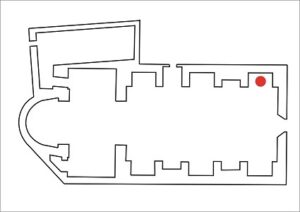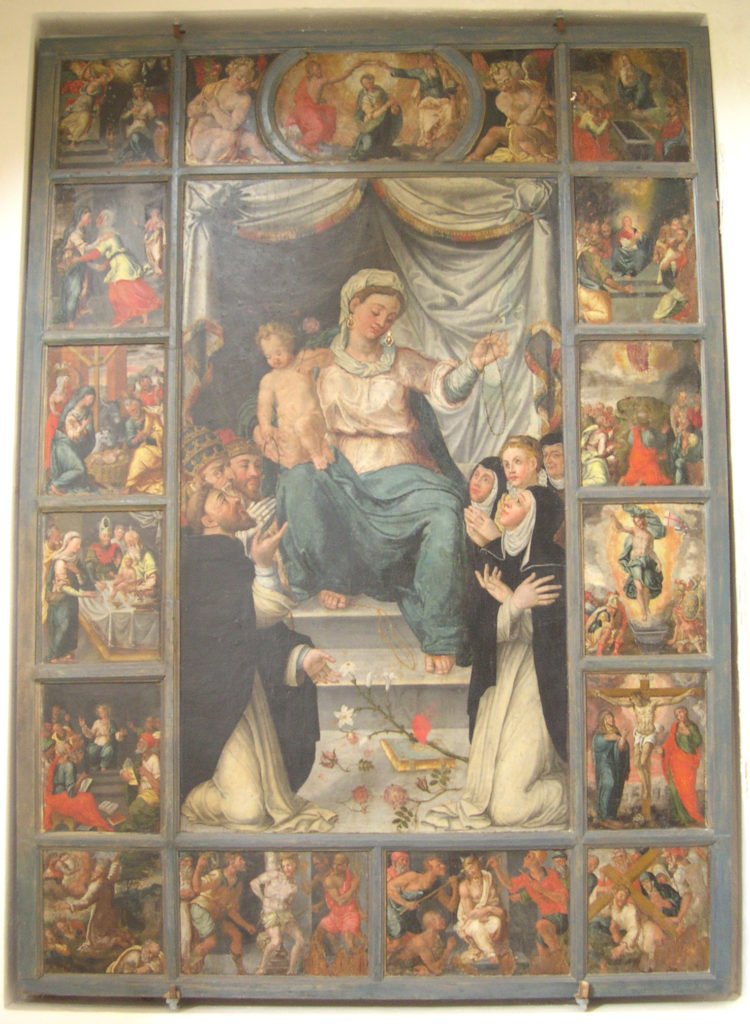Madonna del Rosario con San Domenico e Santa Caterina, santi e misteri del Rosario


Chiesa di S. Maria Maggiore
Pala d’altare
Hendricksz Dirk detto Teodoro d’Errico (cerchia)
Madonna del Rosario con San Domenico e Santa Caterina, santi e misteri del Rosario
Sec. XVI (fine) – sec. XVII (inizio)
Olio su tela

Church of S. Maria Maggiore
Altarpiece
Hendricksz Dirk called Teodoro d’Errico (circle)
Madonna of the Rosary with San Domenico and Santa Caterina, saints and mysteries of the rosary
XVI century (end) – XVII century (beginning)
Oil on the table
La tavola si trovava in origine nella Chiesa del Rosario, annessa al convento domenicano fondato verso la metà del XVI secolo e chiuso per mancanza di rendite nel 1652.
All’inizio del Settecento la tavola venne trasferita nella Chiesa Madre e posizionata nella prima cappella a destra. L’opera è composta da un pannello centrale raffigurante la Madonna con Bambino al centro, sulla sinistra San Domenico di Guzman, Papa Pio V e Filippo II di Spagna, posizionati a sinistra; sulla destra sono riconoscibili S. Caterina da Siena, una suora domenicana e due personaggi che potrebbero essere i committenti. Tra i due santi domenicani, ai piedi della pedana sulla quale è assisa la Madonna, sono presenti i loro attributi iconografici, il libro sacro ed il giglio. Intorno alle figure centrali, ci sono 15 riquadri raffiguranti i misteri del Rosario.
Partendo da sinistra e in senso antiorario individuiamo, sul lato sinistro: L’Annunciazione dell’Arcangelo Gabriele a Maria Vergine; La visita di Maria Vergine a Santa Elisabetta; La nascita di Gesù; La presentazione di Gesù al Tempio; Il ritrovamento di Gesù al Tempio. In basso: L’agonia di Gesù nell’orto degli ulivi; La flagellazione di Gesù alla colonna; L’incoronazione di spine; L’incontro tra Gesù e Maria sulla via del Calvario. Sul lato destro, risalendo: La crocifissione e la morte di Gesù; La Resurrezione di Gesù; L’Ascensione di Gesù al Cielo; La discesa dello Spirito Santo nel Cenacolo; L’Assunzione di Maria Vergine al Cielo. Al centro sopra il pannello centrale, tra due angeli in un ovale abbiamo: L’incoronazione di Maria Vergine.
The table was originally located in the Church of the Rosary, annexed to the Dominican convent founded in the mid-sixteenth century and closed due to lack of income in 1652.
At the beginning of the eighteenth century the table was transferred to the Mother Church and placed in the first chapel on the right. The work consists of a central panel depicting the Madonna and Child in the middle, San Domenico di Guzman, Pope Pius V and Philip II of Spain, positioned on the left; on the right you can recognize St. Catherine of Siena, a Dominican nun and two characters who could be the patrons. Between the two Dominican saints, at the foot of the platform on which the Madonna is seated, there are their iconographic attributes, the sacred book and the lily. Around the central figures, there are 15 panels depicting the mysteries of the Rosary.
Starting from the left and anticlockwise we identify, on the left side: The Annunciation of the Archangel Gabriel to the Virgin Mary; The visit of the Virgin Mary to Saint Elizabeth; The birth of Jesus; The Presentation of Jesus in the Temple; The finding of Jesus in the Temple. Below: The agony of Jesus in the garden of olives; The flagellation of Jesus on the column; The crowning with thorns; The meeting between Jesus and Mary on the way to Calvary. On the right side, going up: The crucifixion and death of Jesus; The Resurrection of Jesus; The Ascension of Jesus into Heaven; The descent of the Holy Spirit in the Upper Room; The Assumption of the Virgin Mary into Heaven. In the center above the central panel, between two angels in an oval we have: The coronation of the Virgin Mary.

L’opera, forse realizzata a Napoli tra la fine del XVI e i primi anni XVII secolo, risente delle influenze dell’arte fiamminga. Alcuni studiosi attribuiscono l’opera a Teodoro d’Errico
The work, perhaps made in Naples between the end of the 16th and the early 17th century, is influenced by the Flemish art and some scholars attribute it to Teodoro d’Errico.
















